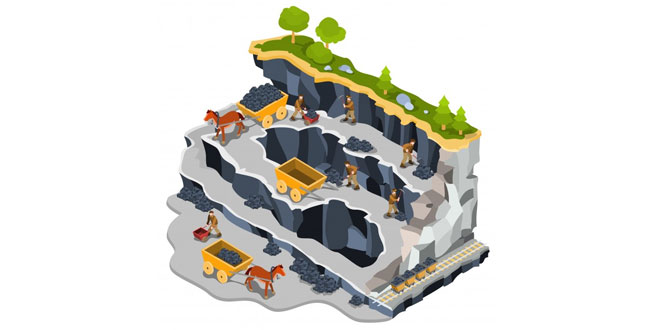Question: How did minerals influence the history of human civilization?
Answer: Minerals have played and important role in the history of human civilization. Therefore, various stages of human development have been named after minerals, such as:
- The stone age: marked the time when humans made weapons and implements from stones.
- Copper Age: Copper was probably the first metal that humans learnt to mine and with its use began the Copper Age.
- Bronze Age: In the Bronze Age humans developed a stronger and more durable metal by mixing copper and tin.
- Iron Age: About 3,000 years ago, the Bronze Age was replaced by the Iron Age.
- Steel Age: Even the Iron Age has been replaced by the Steel Age in modern times.
Question: Why is petroleum called ‘black gold’?
Answer: Minerals oil has great importance in the economy. A variety of products, like petrol, diesel, kerosene, wax, plastics and lubricants are obtained by refining crude mineral oil. Other by-products include raw materials for chemical fertilizers, synthetic fibers and drugs. Thus, it is called ‘black gold’.
Question: Explain the methods of mineral extraction.
Answer: The method used for mineral extraction depends upon the depth at which the minerals occur.
- When mineral ores occur near the surface, they are simply dug out. This is called Quarrying.
- When mineral ores are located at a shallow depth, they can be taken out by removing the surface layer. This is called open-pit or open-cast mining.
- Some mineral deposits occur at great depth. A shaft has to be dug to reach the minerals. Such a mine is called a shaft mine. A shaft mine has many underground chambers. The miners use lifts to reach these chambers.
- Deep wells are dug to extract oil and natural gas. The process of digging wells and extracting mineral oil is known as drilling.
Question: What are minerals? Discuss different types of minerals on the basis of their composition in detail.
Answer: Minerals are non-living substances which are concentrated in a particular area or rock formation. On the basis of composition, minerals are broadly classified into metallic and non-metallic.
Metallic Minerals:
- Metallic minerals are basically found as ores.
- We get metals such as iron, gold and copper from metallic minerals.
- Most of the metallic are found in igneous and metamorphic rocks.
- These minerals are hard and have lustre.
- The metallic minerals can be further divided into two types – ferrous and non-ferrous.
- The ferrous minerals contain iron, like iron ore, manganese and chromite.
- The non-ferrous minerals do not contain iron, but may contain some other metal such as copper, silver, lead and gold.
Non-metallic Minerals:
- Non-metallic minerals do not have metals in them.
- They include nitrate, sulfur, potash, salt and coal.
- Petroleum and coal are used as fuel or sources of power.
- Therefore, they are also called mineral fuels.
- Non-metallic minerals are usually found in sedimentary rocks.
 Class Notes NCERT Solutions for CBSE Students
Class Notes NCERT Solutions for CBSE Students


